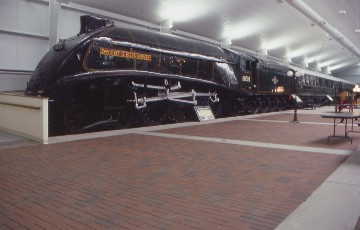
At the Ramada Inn in Chicago, no hot water greeted this traveller when I awoke and after I checked out, I walked the empty streets of Chicago back to Union Station in the pre-dawn hour. It was a breezy morning with the wind really blowing from the north. I picked up USA Today and had the usual MacDonald's breakfast before boarding the Hiawatha for Milwaukee, departing on time with a consist of P42DC 175, Horizon coaches 54525, 54535 and 54514, all red seats, Horizon coach 54521 with green seats, meaning it had rebuilt, and cabbage car 99215. Our route passed such landmarks like Lake Tower, A2 Tower and the Metra Milwaukee Lines shops before venturing out into the northern suburbs, stopping at Glenview before crossing the Elgin, Joliet and Eastern at Rondout prior to reaching Wisconsin, where the countryside had a more rural and forested atmosphere. The landscape then became rolling with farming as our southbound sister train passed us on the fly. We stopped at Sturtevant then all too soon arrived at our final stop of Milwaukee.
I went into the station to wait for Hertz to open and the agent arrived, helped me immediately and I was on my way forty-five minutes before they opened. In my Chevy Cavalier, I drove north on Interstate 43 to Green Bay with views of Lake Michigan to the east in various locations. I took Highway 174, where my next destination came into view as I crossed the Fox River.
National Railroad Museum HistoryThrough a designation by Congress, catalyzed by the work of U.S. Representative John Byrnes and Senator Alexander Wiley, the National Railroad Museum became the only congressionally designated railroad museum in the United States. The Museum operates as a privately funded 501(c)(3) educational organization and is among the largest railroad museums in the nation.
Located on Cooke Memorial Park, and later adding a portion of land owned by Brown County, the National Railroad Museum's 33 acres is the site of an increasing collection of rolling stock. Some pieces are housed in our beautiful, enclosed Frederick J. Lenfestey Center, while others are on display outside and under the roof of the Victor McCormick Train Pavilion. As old freight equipment was replaced and passenger travel declined, the Museum acquired unique locomotives such as Union Pacific 4017 "Big Boy", the Pershing and Dwight D. Eisenhower locomotives, and more pieces representative of United States railroad history. The Museum now features more than 70 pieces of rolling stock, 100,000-plus small artifacts, operating/display tracks, seasonal train rides and special events.
The Museum's staff members and 200+ volunteers warmly welcome and help educate more than 100,000 visitors annually from across the country and around the world. Despite its status as the only Congressionally designated national- status railroad museum in the United States, the National Railroad Museum receives no federal, state or local tax support. Funds supporting Museum operations come from admissions, grants, memberships, fundraising events, mission-related business activities and the generosity of private donors.
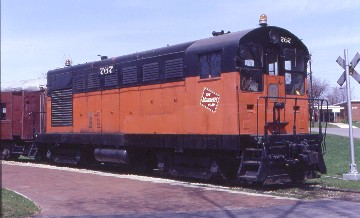
I was greeted by Milwaukee Road H-10-44 767, nee Milwaukee Road 1809, built by Fairbanks-Morse in 1945, in beautiful paint. I parked and went inside to pay my fare, as well to introduce myself to the staff and had received special permission to use my tripod for pictures of their indoor collection.

British Railways streamlined 4-6-2 60008 "Dwight D. Eisenhower". Designed by London and North Eastern's Nigel Gresley for fast passenger service between London, Scotland and the North of England it was outshopped from the railway's Doncaster Works in the United Kingdom in September 1937. This coal-burning Pacific type locomotive was originally numbered 4496 and named "Golden Shuttle". It was renamed "Dwight D. Eisenhower" and renumbered 8 after World War II. With nationalisation of the British Rail system in 1948, the locomotive became 60008. It spent much of its operating life working out of Kings Cross, London and was finally withdrawn from service in July 1963. The following year, the engine was restored at Doncaster and donated to the National Railroad Museum. It was shipped to the United States, arriving in May 1964. In October 1990, 60008 was moved to Abilene, Kansas, for the celebrations of the centenary of Eisenhower's birth.
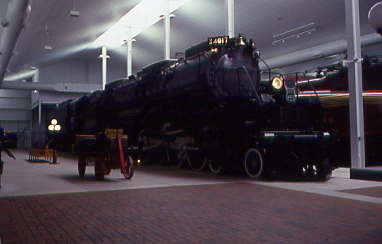
Union Pacific Big Boy 4-8-8-4 4017 built by American Locomotive Company in 1942. It is one of eight surviving Big Boy locomotives, the largest steam engine ever built.
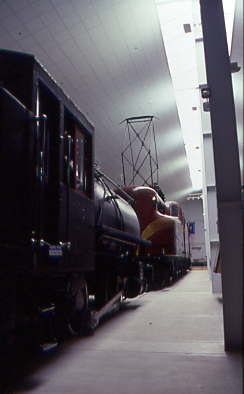
Pennsylvania Railroad GG1 4890 built by the railroad in 1940. The GG1 was a Pennsylvania Railroad design intended to haul a consist of 12-14 passenger cars on the electrified sections of the system between New York, Washington, DC, and Harrisburg, Pennsylvania. The tapered hood sides and centre cab were a product of concerns for crew safety, as they provided better visibility when running in either direction. GG1s were mainly used to haul passenger trains but some were regeared for freight service. 4890 was on display at the B&O Museum until 1995 when it was bought by the National Railroad Museum.
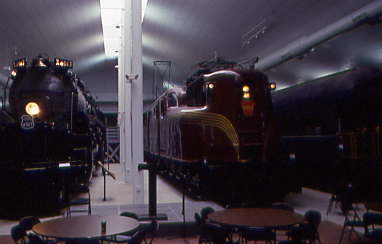
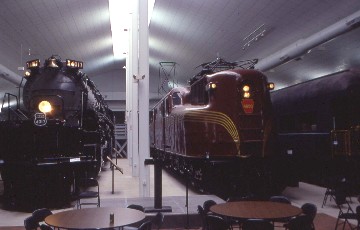
Union Pacific 4017 and Pennsylvania Railroad 4890.
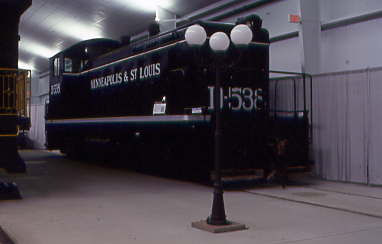
Minnesota & St. Louis NW-1 D-538 built by Electro-Motive Corporation in 1938. It was sold to the Marinette, Tomahawk & Western in 1957 and continued in service on that railroad until 1973, when it was donated to the museum.
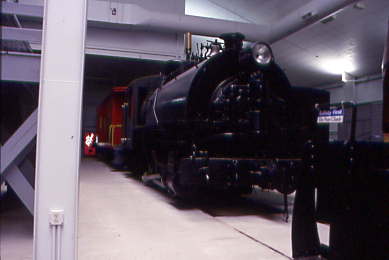
National Railroad Museum 0-4-0T 29 "Brillion Pioneer", ex. Jennie Fuller Estate Green Bay 1961, exx. The Purdey Company (dealer), exxx. Pullman Inc 29 1959, exxxx. Pullman Car and Manufacturing 29 1934, exxxxx. W.F. Carey Company Incorporated 5 1923, nee built for stock by Alco-Cooke in 1923. When it worked for Pullman it switched the yards of the company town of Pullman, Illinois, fourteen miles south of Chicago until the late 1950's. From 1962, with a plate bearing "Brillion Pioneer" attached to its foot boards, 29 hauled trains for the museum's tourist "Wisconsin & Yesterday Railroad". Unfortunately, complaints from locals along the route forced it into retirement.
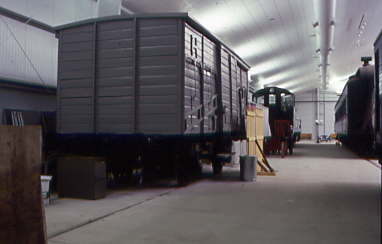
Wisconsin State Merci Car from France, which toured Wisconsin communities in 1949.
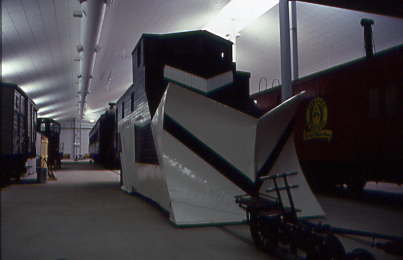
Escanaba & Lake Superior Railroad wedge snowplough P100. The E&LS was founded in 1898 and was bought by Hanna Mining in the early 1960s. In 1978, John Larkin, a Minneapolis businessman bought the line, which still operates 208 miles of track from Ontonagon, Michigan, to Green Bay, Wisconsin. I next toured the Victor McCormick Train Pavilion.
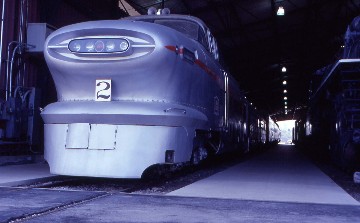
Rock Island Aerotrain 2 built by General Motors in 1955. Following World War II, with greater car ownership, growth of the nation's interstate highway system and air services, railway passenger numbers began to decline. In response, railroads sought ways to attract passengers back, including introducing stylish trains that combined speed and added luxury. One such effort was General Motors' "Aerotrain", unveiled in 1955. The trainset is essentially a combination of GM bus bodies re-styled and adapted to run on rails and hauled by a diesel engine. The GM "style" is evident in the windshield design, smooth front end lines with recessed headlights, and the fin-like wrap-around just above the pilot.
The first railroad to test one of the new trains in February 1956 was the Pennsylvania Railroad, but the lightweight coaches, single-axle trucks and a suspension system designed for buses made for a very uncomfortable ride at high speed. The Pennsy was not convinced and returned the train to GM after a year of use. GM took the trains on a tour of the country in an effort to drum up interest, but the same problems arose and no-one was willing to buy. Finally, in 1957, they were sold to the Rock Island for commuter services in Chicago, where lower speeds applied but after only nine years, in 1966, both trains were retired.
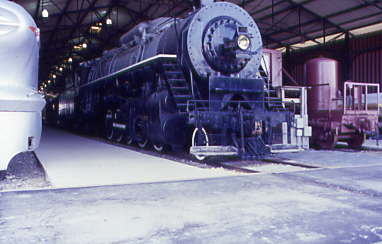
Duluth, Missabe and Iron Range Railway E-1 class 2-10-2 506 built by American Locomotive Company in 1919. It remained in service until 1962 and was donated to the museum the same year.
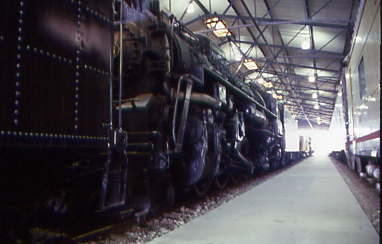
Chesapeake and Ohio K-4 2-8-4 2736 built by American Locomotive Company in 1944. All the K-4s had been retired by 1957 and the majority scrapped by 1961 with only twelve surviving.
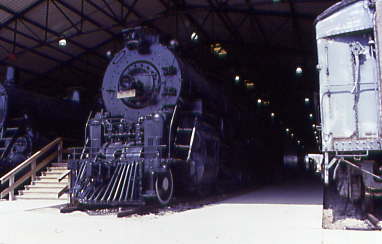
Santa Fe 2-10-4 5017 built by Baldwin in 1944. 5017 worked on the Santa Fe Pecos Division between Clovis and Belen, New Mexico but travelled as far afield as Texas, Oklahoma and Colorado. It ran up a total of 750,000 miles in its fifteen year life. Retired in 1959, it was donated to the museum that year.
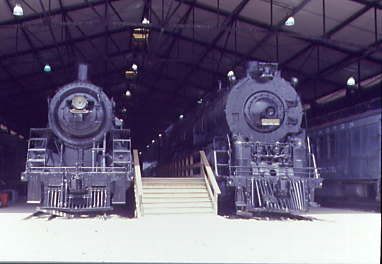
SOO Line 2718 and Santa Fe 5017.
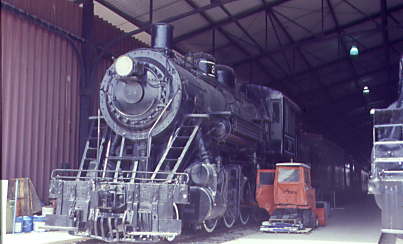
Lake Superior and Ishpeming Railroad 2-8-0 24, ex. Munising, Marquette and Southeastern 40 1911, nee Marquette and Southeastern Railway 40, built by American Locomotive Company in 1910. The Marquette and Southeastern operated a sixty mile line between Big Bay and Lawson, Michigan. In 1911, the Marquette & Southeastern merged with the Munising Railway, a short line between Munising and Princeton, Michigan. The Munising, Marquette & South Eastern Railroad merged with the Lake Superior & Ishpeming Railroad in 1923.
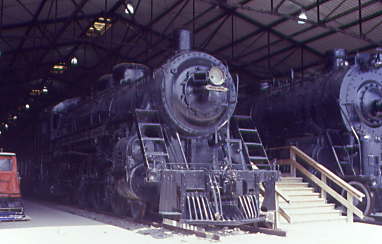
Minneapolis, St. Paul and Sault Ste. Marie Railroad 4-6-2 2718 built by American Locomotive Company in 1923. The Soo Line was started in 1883 by a consortium of flour mill owners in Minneapolis to connect its two namesake cities and avoid sending shipments through Chicago. It was never a major passenger carrier as its line between Chicago and Minneapolis/St Paul was much longer than its competitors, the Milwaukee Road, Chicago & North Western and the Chicago, Burlington & Quincy. 2718 was in service for twenty-five years until 1958, when the Soo Line donated it to the museum.
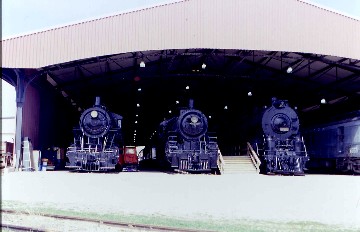
Lake Superior and Ishpeming 24, SOO Line 2718 and Santa Fe 5017, after which. I returned outside.
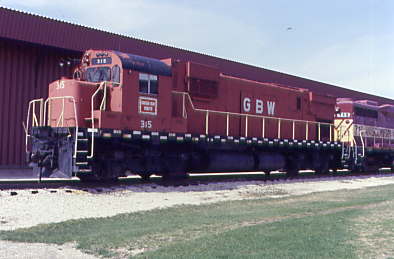
Green Bay and Western C430 315 built by American Locomotive Company in 1968. After suffering a broken crankshaft in 1986, it was retired. In 1987, the GB&W donated it to the museum.

Milwaukee Road E9A 38A built by Electro-Motive Division in 1961.
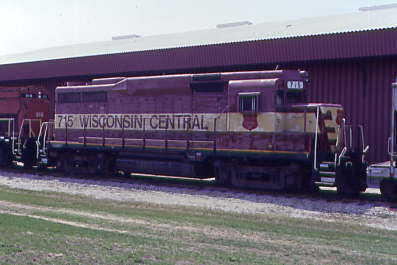
Wisconsin Central GP30 715, nee SOO Line 715 built by Electro-Motive Division in 1963.
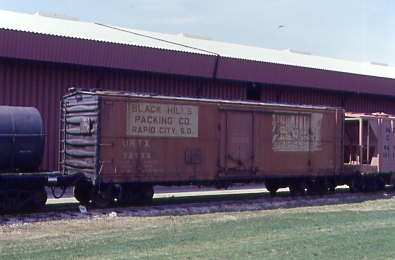
Black Hills Packing Company URTX 72733 built by General American in 1948.

Bangor & Aroostook BL2 56, nee Bangor and Aroostook 556 built by Electro-Motive Division in 1949. The BL stood for "branch line", meaning these locomotives were intended for lines with light traffic or limits on axle loadings. Something of a hybrid, the BL2 was used to haul freight and, occasionally, passenger trains as well as performing switching duties.
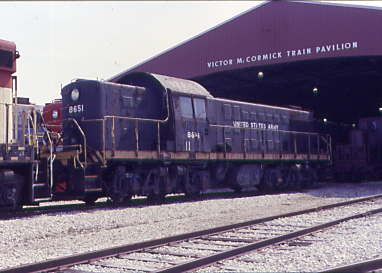
United States Army RSD-1 8651 built by American Locomotive Company in 1945.
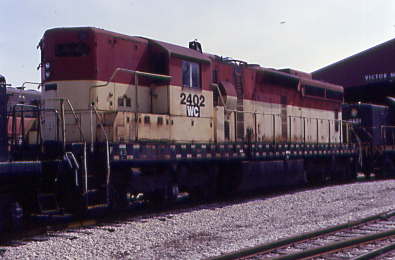
Wisconsin Central SD24 2402, ex. Fox River Valley 2402, exx. Maryland Midland 6250, exxx. Burlington Northern 6250 1970, nee Chicago, Burlington and Quincy 510, built by Electro-Motive Division in 1959.
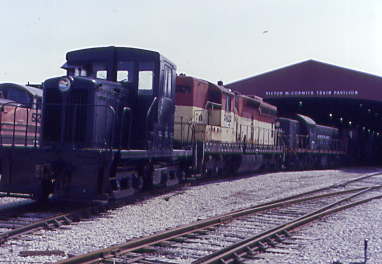
Museum sceene.
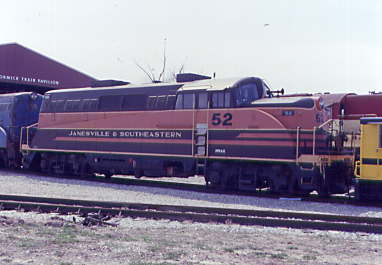
Janesville & Southern BL2 52, ex, Bangor and Aroostook 52, nee Bangor and Aroostook 552, built by Electro-Motive Division in 1949. The BL stood for "branch line", meaning these locomotives were intended for lines with light traffic or limits on axle loadings. Something of a hybrid, the BL2 was used to haul freight and, occasionally, passenger trains as well as performing switching duties.
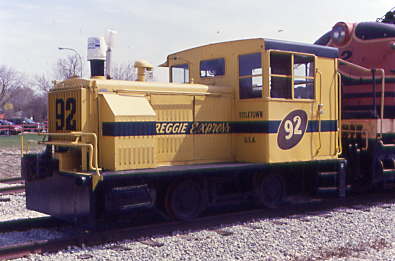
Reggie Express JCD 20 ton switcher 92, ex. Busch Brewing "Miss Budweiser", exx. Rahr Brewing, exxx. Anhauser-Busch, nee McKenzie-Hauge-Simmonds built by Plymouth in 1947. It is painted for Green Bay Packer 92 Reggie White.
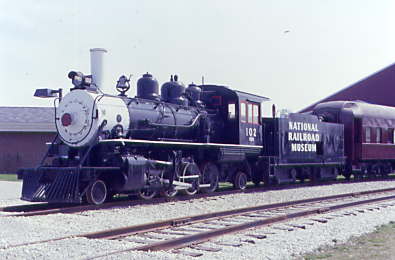
Sumter & Choctaw Railway 2-8-2 102 built by Baldwin in 1924. The Sumter & Choctaw was owned by the Allison Lumber Company in Bellamy, Alabama, serving the two namesake counties in western Alabama. 102 was donated to the museum in 1964. In 1988, the museum sent the locomotive to the Green Bay & Western Norwood roundhouse, where it spent nearly eighteen months being rebuilt with a diesel engine from an old center-cab switcher fitted to the tender so that it can haul trains, although not in steam.
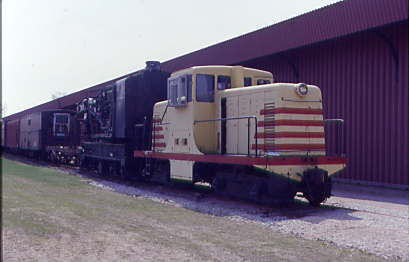
Museum scene.
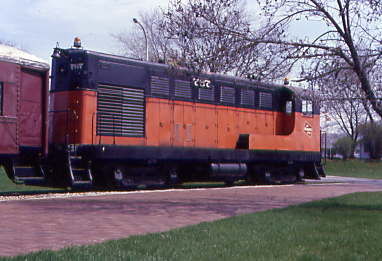
Milwaukee Road H12-44 767.
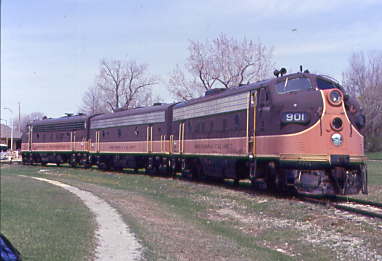
Janesville & Southeastern F-units.
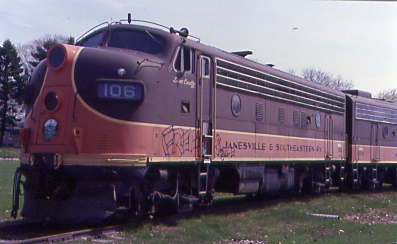
Janesville & Southeastern F7A 106, ex. Wisconsin and Calumet 106, nee Milwaukee Road 117C built by Electro-Motive Division in 1951.
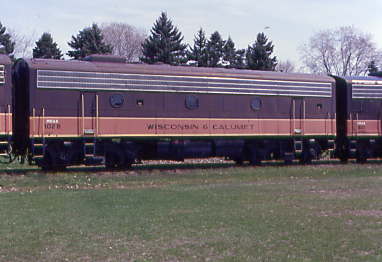
Wisconsin & Calumet F7B 102B, nee Milwaukee Road 102B, built by Electro-Motive Division in 1951.
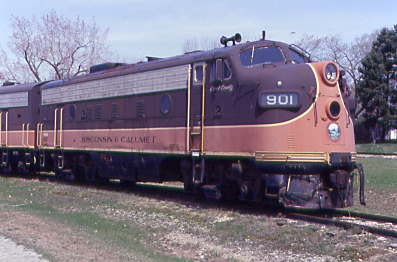
Wisconsin & Calumet F7A 901, ex. Charleston and Western Carolina 901, exx. Chicago, Madison and Northern 564, exxx. Glen Monhart 1980, exxxx. American Crystal Sugar Company 64 1970, exxxxx. American Carrier Equipment 64, nee Denver and Rio Grande Western 564D built by Electro-Motive Division in 1949.

National Railroad Museum 2 truck shay 5, ex. George Banta 5 1972, exx. H.F. Allen & Casimir Samborski 5 1955, exxx. Ely Thomas Lumber Company 5, exxxx. West Virginia Midland Railroad, nee Pardee and Curtin Lumber Company 12 built by Lima Locomotive Works in 1917.
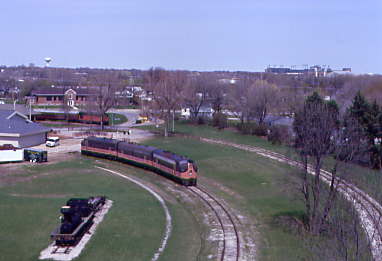
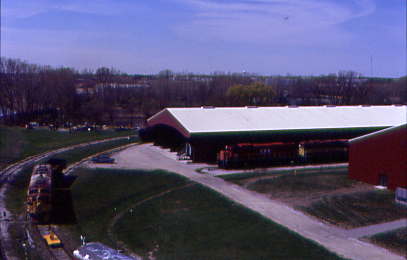
I walked out to the observation tower which provided a great overall view of not only the museum grounds, but the surrounding Green Bay area.
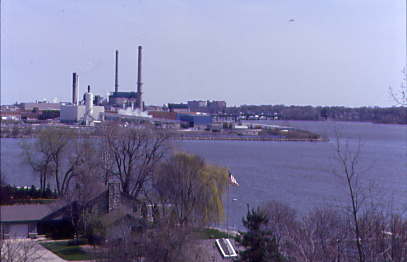
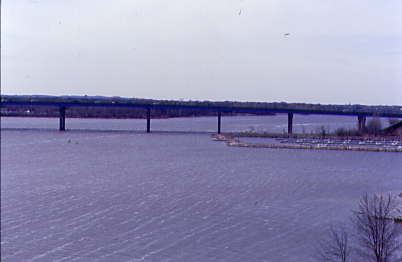
The Fox River from the tower.
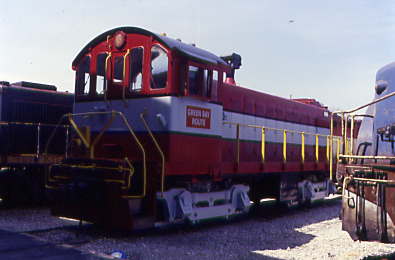
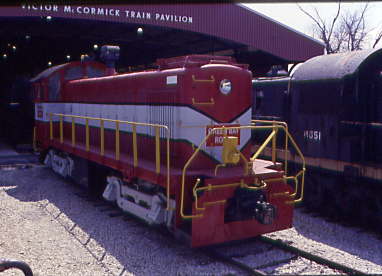
Green Bay Western S1 402. I next rode the museum's train around the loop pulled by Milwaukee Road 767, riding in a former Lackawana electric coach named "Josephine" while the other coach was Chicago and North Western 7411. Tim Tennant was our conductor and gave us plenty of information along the route. We stared by crossing the main road into the museum and minutes later, stopped by the observation tower where Tim discussed the Joseph Leicester, a hospital car, one of two the C&NW had that carried patients from Chicago to the Mayo Clinic in Rochester, Minnesota.
We next stopped on the bridge over Dutchman Creek where it flows into the Fox River, passed the Haunted House then traversed Dutchman Creek again before crossing the leads to the Canadian National trackage and the outside rail world. We stopped at the Hood Junction depot, thus completing the loop around the museum and inside was a large model railroad display. I really enjoyed my visit to this truly unique railroad museum.
The Return to JanesvilleI drove to a Walgreen's for postcards before taking US 41 South to Wisconsin Highway 24 and stopping in Watertown for a few minutes before continuing south to Janesville.

I stopped by the Wisconsin Southern shops and found Wisconsin Southern SD20 2055, ex. Wisconsin Southern 2015, exx. Illinois Central Gulf 2015, exxx. Southern 6342, nee Southern 2523 built by Electro-Motive Division in 1959, then visited another Walgreen's here for more postcards before going to the Baymont Inn to get a room for the night and I was most surprised to receive the same room I had on my "Janesville Jaunt" adventure in June 2000.

I went over to see what was left of the former Amtrak stop for this city then drove to Applebee's for a steak dinner and filled the car with petrol before returning to my room to relax for the evening.
| RETURN TO THE MAIN PAGE |